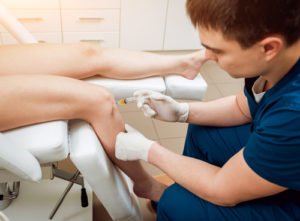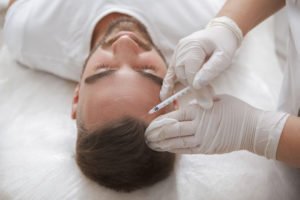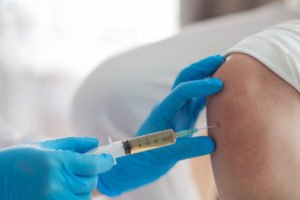
Platelet-rich plasma (PRP) therapy may improve the symptoms of various degenerative conditions that affect the joints in knees. The therapy isolates factors in the patient’s blood that promote recovery and uses them to target specific conditions that affect knee health.
Platelet-Rich Plasma Therapy Explained
Platelets in blood serve a number of purposes, including:
- Promoting healing
- Promoting clotting
The first primary function of platelets — healing — is the scientific basis for platelet-rich plasma (PRP) therapy, according to Healthline. Here is how PRP therapy is administered:
- A medical professional will draw an appropriate amount of blood from the patient’s body.
- That blood will then be transferred into a centrifuge, which manipulates the blood in a way that separates the platelets — rich in proteins and other growth factors — from the other elements that comprise blood.
- The doctor will then inject those isolated platelets into the area of the body being targeted through the PRP therapy.
Those who receive platelet-rich plasma therapy for their knees are interested in the ways that platelets can promote healing in the body’s various tissues — specifically, tissues that promote health and reduce pain in the knees.
For a free consultation, call (305) 682-1818
Knee Conditions That May Improve Due to PRP Treatment
Some of the degenerative joint conditions that may improve as the result of platelet-rich plasma therapy include:
- Injuries to the anterior cruciate ligament (ACL), medial collateral ligament (MCL), and posterior cruciate ligament (PCL), including but not limited to tears and strains
- Knee tendinitis, which occurs commonly in athletes and those who put frequent strain on their knees
- Arthritis, a painful condition that may be partially or completely due to unavoidable genetic factors.
- Instability of the knee, which may increase susceptibility for injury
Because the knees bear the brunt of most of a human’s body weight, they accumulate more wear and tear at a more rapid clip than most other body parts. This is especially true for those who are highly active or have more weight resting on their knees than most. As a result, a significant number of people suffer from the above knee conditions.
Another knee condition that becomes increasingly likely as someone grows older is osteoarthritis. The effectiveness of platelet-rich plasma therapy as a treatment for osteoarthritis has been studied more than most other conditions, and the results illustrate PRP’s potential to help overall knee health. In short, it’s worth a close look to see how PRP works for knees.
The Data Supporting PRP for Osteoarthritis and Other Conditions
The goal of PRP therapy is to reduce the pain that those with knee problems feel, as well as to help their ability to move around. In some sense, these goals go hand-in-hand, as a person who experiences less knee pain may be more inclined to move.
Data suggests that platelet-rich plasma therapy may be effective in achieving both of these important health outcomes. This is how PRP works for knees. Keep in mind that the measurable benefits of reduced pain and increased mobility are often the results of tissue (or cartilage) growth.
A study published in The Journal of Arthroscopic & Related Surgery
found that the injection of stem cells (which contain similar growth factors to those active in PRP) improved the amount of cartilage in patients’ knees. The researchers behind the study made conclusions that suggest the greater the number of PRP injections, the more improvement in knee cartilage a patient may see.
In a different study published in the International Journal of Rheumatic Diseases, patients who received stem cell injections in degenerating knees experienced improvements in overall knee function that lasted as long as five years. The British Journal of Sports Medicine published a roundup of studies showing the positive impact on knee health that has come from the injection of stem cells mirroring PRP therapy.
Knee Pain and Restriction Is a Common Reality of Aging
The body begins to decline steadily with age. This is not pretty, but it is a reality nonetheless, and the knees may show the true toll of aging more than any other part of the body.
It is critical to recognize the degenerative nature of knees, especially if you are predisposed to degenerative knee conditions or have lived in a way that may makes you more susceptible to wear and tear on the knees.
Fortunately, PRP’s effect on knees has been seen in studies, and this therapy has emerged as a non-invasive, non-surgical means of improving knee health while fighting the effects of cartilage degeneration. You should not be content to let your knees grow stiffer and more painful as youage. Instead, you should take steps to improve the feeling and mobility of your knee joints today.
Click to contact our specialist today
I Can Contact HealthGAINS Today to Learn More
The team at HealthGAINS is happy to answer all questions and can schedule an appointment today so that you can find out how PRP works for knees. Contact HealthGAINS at (305) 912-8828 as soon as possible for a free consultation.
Call or text (305) 682-1818 or complete a Free Consultation Form








